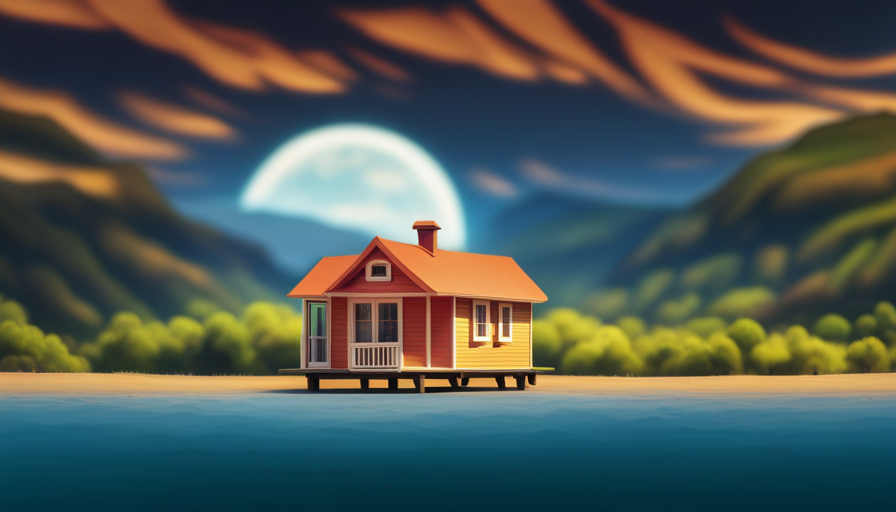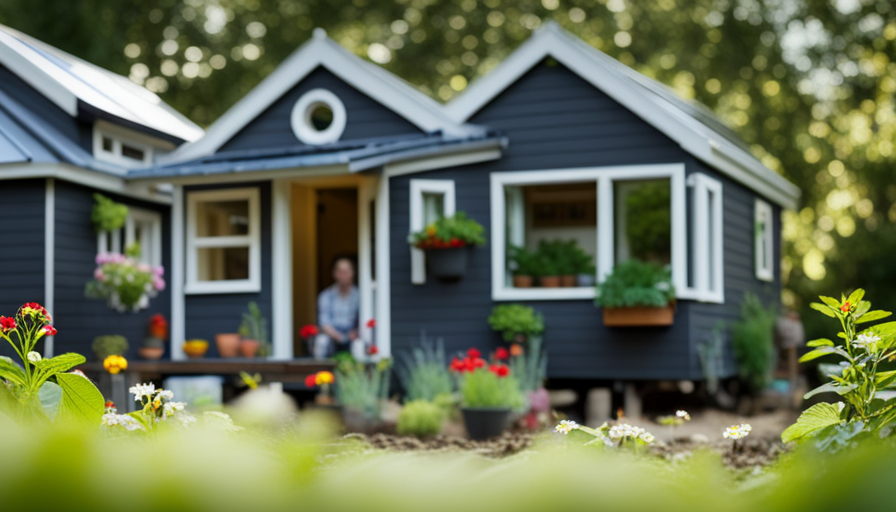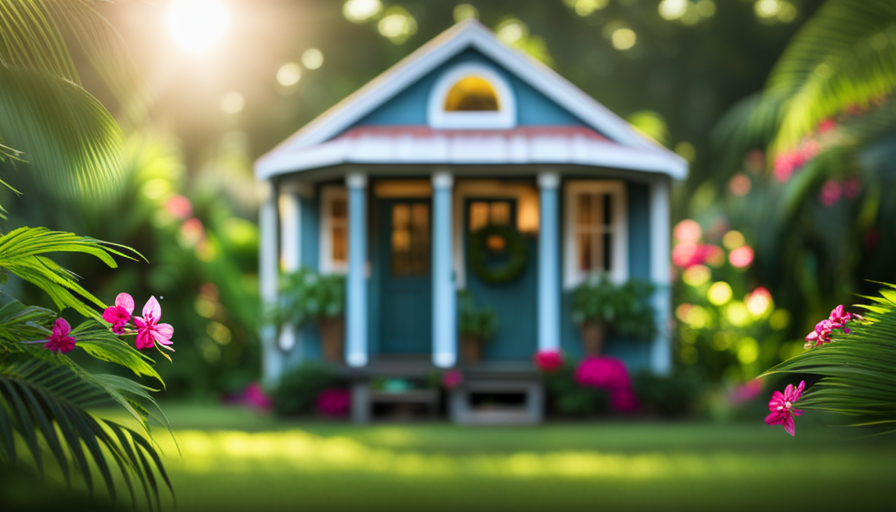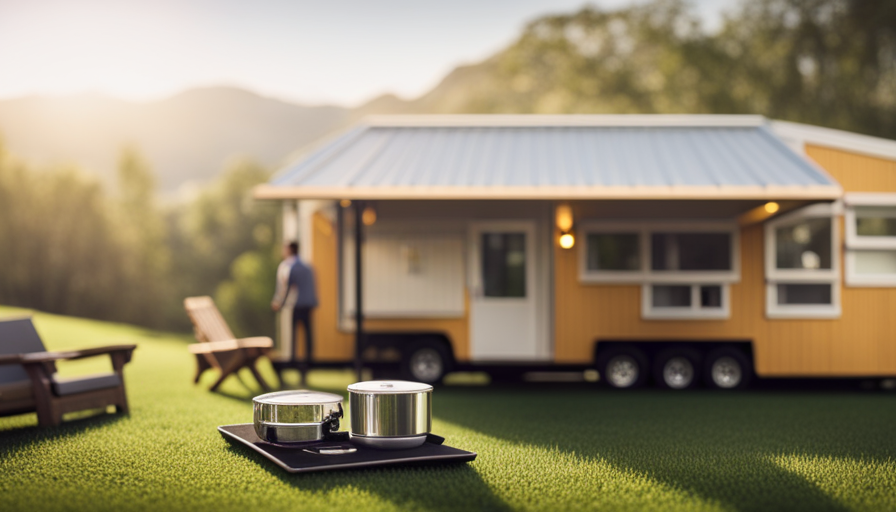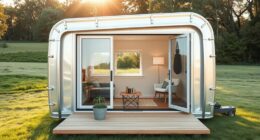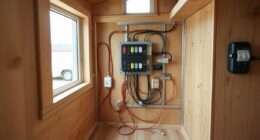Have you ever wondered how big a tiny house on wheels can actually be? Prepare to be amazed by the possibilities. These compact homes are truly limitless in their potential, thanks to creative design techniques and clever use of space. When it comes to size and functionality, the sky’s the limit.
But here’s the catch – it’s not about the physical dimensions alone; it’s about thinking outside the box, pushing boundaries, and challenging conventional norms. In this article, I will take you on a journey through the world of tiny houses on runners, exploring the maximum dimensions, customization options, and tips for maximizing space.
We’ll even dive into real-life case studies of incredibly spacious tiny houses on runners that will leave you in awe. So, get ready to reimagine what’s possible and discover how big a tiny house on runners can truly be.
Key Takeaways
- Tiny houses on runners have a wide range of sizes, typically ranging from 100 to 400 square feet.
- Zoning regulations and building codes determine the maximum dimensions, with a typical maximum width of 8.5 feet and maximum height of 13.5 feet.
- Design considerations for tiny houses on runners include weight, height, width, and length, allowing for customization options and personal touches.
- Maximizing space in a tiny house on runners can be achieved through multi-functional furniture, creative storage solutions, and utilization of vertical space and hidden compartments.
The Basics of Tiny Houses on Runners
So, you’re probably wondering how big your tiny house on runners can actually be, right? Well, let me tell you, the possibilities are endless!
When it comes to tiny houses on runners, understanding zoning regulations is crucial. Different areas have different rules and restrictions on the size of these mobile homes. However, in general, tiny houses on runners can range from around 100 square feet to 400 square feet.
The benefits of mobility are incredible. You can easily move your tiny house on runners to different locations, whether it’s for work, travel, or just a change of scenery. It gives you the freedom to explore and live in different places without the hassle of selling or renting a new home.
Understanding size limitations is important, as it will help you design and build a tiny house that meets your needs and complies with regulations. So, let’s dive into the next section and explore the various size limitations you should keep in mind.
Understanding Size Limitations
Although it may seem counterintuitive, envision a miniature abode equipped with mobile appendages that enable it to gracefully glide across the landscape like a ballerina. As charming as this concept may be, designing a tiny house on runners requires careful consideration of size limitations imposed by building codes and practicality.
Here are four design considerations to keep in mind:
1) Weight: The house must be light enough for the runners to support and maneuver easily.
2) Height: The structure should not exceed a certain height to avoid potential obstacles during transportation.
3) Width: The width must comply with road regulations to ensure safe and legal transportation.
4) Length: The length should be balanced to maintain stability and prevent any issues during movement.
Understanding these design considerations is crucial when determining the maximum dimensions for tiny houses on runners. With these factors in mind, let’s explore the practical limitations in the subsequent section about ‘maximum dimensions for tiny houses on runners’.
Maximum Dimensions for Tiny Houses on Runners
One important consideration when designing a miniature dwelling with mobile appendages is the maximum dimensions it can have while still remaining within the constraints of building codes and practicality. Building codes and zoning regulations determine the maximum height, width, and length of a tiny house on runners.
These regulations are in place to ensure that the structure is safe, structurally sound, and doesn’t exceed the limitations of the surrounding area. The specific dimensions may vary depending on the location and jurisdiction, but typically, tiny houses on runners are limited to a maximum width of 8.5 feet and a maximum height of 13.5 feet.
These limitations ensure that the tiny house can be transported safely on the road and fit within standard parking spaces. It’s important to carefully consider these dimensions when customizing your tiny house on runners to ensure compliance with building codes and zoning regulations.
Now, let’s explore how you can customize your tiny house on runners to suit your unique needs and preferences.
Customizing Your Tiny House on Runners
When it comes to personalizing your mobile dwelling, how can you make it uniquely yours? There are countless customization options available for your tiny house on runners, allowing you to create a space that reflects your personal style and needs.
Here are four design considerations to keep in mind:
-
Layout: Think about how you want to use the space and consider different floor plan options. Will you prioritize a spacious living area or a larger kitchen?
-
Storage: Maximizing storage is crucial in a tiny house. Look for creative solutions like built-in cabinets, hidden compartments, and multi-purpose furniture.
-
Colors and Materials: Choose a color palette and materials that resonate with your aesthetic. Lighter colors can make a small space feel more open, while natural materials can bring warmth and character.
-
Personal Touches: Don’t forget to add personal touches like artwork, photographs, and decorative items that make your tiny house feel like home.
With these customization options in mind, you can design a tiny house on runners that suits your unique taste and lifestyle. Now, let’s explore some tips for maximizing space in your tiny abode on wheels.
Tips for Maximizing Space in a Tiny House on Runners
When it comes to maximizing space in a tiny house on runners, I’ve found that multi-functional furniture and appliances are absolute game-changers. Being able to transform a sofa into a bed or a dining table into a workspace makes all the difference in such a compact living space.
Additionally, getting creative with storage solutions is essential. From utilizing vertical space with shelves and hooks to building hidden compartments and utilizing under-bed storage, every nook and cranny becomes valuable real estate.
Multi-functional Furniture and Appliances
Imagine transforming your tiny house on runners into a space where every piece of furniture and appliance serves multiple purposes, making the most out of your limited square footage. With space-saving design and compact living in mind, the possibilities are endless.
Picture a sofa that can be converted into a bed at night, a dining table that doubles as a workspace, and a coffee table with hidden storage compartments. These multi-functional furniture pieces not only save space but also add versatility to your tiny house.
Appliances can also play a dual role, such as a washer/dryer combo or a refrigerator with built-in freezer drawers. By maximizing the functionality of your furniture and appliances, you can truly optimize the space in your tiny house on runners.
Now, let’s explore some creative storage solutions to further enhance your tiny living experience.
Creative Storage Solutions
To make the most out of your limited space, think outside the box and consider clever storage solutions that’ll help you keep your belongings organized and easily accessible.
In a tiny house on runners, space-saving hacks and innovative design are essential. One creative storage solution is utilizing vertical space by installing shelves or racks on walls. This allows you to maximize storage without taking up valuable floor space.
Another idea is incorporating multi-functional furniture with hidden compartments, such as ottomans or beds with built-in drawers. These hidden storage spaces are perfect for stashing away items that you don’t need on a daily basis.
Additionally, utilizing the area under stairs or in unused corners can provide extra storage space.
By incorporating these creative storage solutions, you can effectively organize your belongings and create a more spacious living environment.
Now, let’s explore some case studies of spacious tiny houses on runners.
Case Studies of Spacious Tiny Houses on Runners
Although it may seem counterintuitive, some tiny houses on runners can actually be quite spacious. These innovative designs prove that size doesn’t always dictate the feeling of space.
Take for example the ‘Nomad’s Oasis’ – a tiny house on runners that boasts a spacious layout with clever storage solutions. The living area features a foldable dining table that can be tucked away when not in use, maximizing the space available. The kitchen is equipped with floor-to-ceiling shelving units that provide ample storage for pots, pans, and utensils.
Another inspiring example is the ‘Wanderlust Retreat’ – a tiny house on runners that incorporates a lofted sleeping area, allowing for a separate and private space. The loft is accessible via a stylish spiral staircase, adding a touch of elegance to the overall design.
With these case studies in mind, it’s clear that tiny houses on runners can offer both functionality and design inspiration.
Frequently Asked Questions
How much does it cost to build a tiny house on runners?
When considering the cost of building a tiny house on runners, it’s important to compare different construction materials. The cost can vary depending on your choices, such as using sustainable materials or opting for high-end finishes.
By exploring various options, you can find the perfect balance between cost and quality. Building a tiny house on runners allows for mobility and freedom, making it an innovative and cost-effective alternative to traditional housing.
Are there any legal requirements or restrictions for parking or living in a tiny house on runners?
Legal requirements and zoning regulations play a crucial role in determining the feasibility of parking or living in a tiny house on runners. Adhering to these rules ensures compliance with local laws and avoids potential legal troubles.
Factors such as minimum square footage, setback requirements, and access to utilities may vary depending on the jurisdiction. It’s essential to research and consult with local authorities to understand the specific restrictions and guidelines before embarking on this unique housing adventure.
Remember, "To be forewarned is to be forearmed."
What are some common design features or amenities found in tiny houses on runners?
Design trends and space-saving solutions are key features in tiny houses on runners. These innovative homes often incorporate multi-functional furniture, such as foldable beds and hidden storage compartments, to maximize every inch of space.
Creative use of vertical space, like loft areas or tall ceilings, allows for additional storage or sleeping areas.
Additionally, clever layouts and open floor plans create a sense of spaciousness. These design features make tiny houses on runners both practical and stylish, perfect for those seeking a minimalist and efficient lifestyle.
Can a tiny house on runners be moved easily from one location to another?
Moving a tiny house on runners can present some challenges, but there are also solutions available. One challenge is ensuring the house is securely attached to the runners to prevent any damage during transportation. Additionally, the weight and size of the house may limit the types of vehicles that can be used to move it.
However, choosing a tiny house on runners over a traditional mobile home offers several benefits, such as the ability to easily relocate and the flexibility to live in unique and unconventional locations.
Are there any financing options available for purchasing or building a tiny house on runners?
There are several financing options available for purchasing or building a tiny house on runners. Many banks and credit unions offer loans specifically for tiny homes, and there are also specialized tiny house lenders that can help with financing.
When considering financing options, it’s important to also consider building regulations, as these can vary depending on location. It’s always a good idea to consult with local authorities or a professional builder to ensure compliance with regulations while exploring financing options.
Conclusion
In conclusion, the possibilities of tiny houses on runners are truly boundless! From understanding the size limitations to customizing your own space, the options are endless.
With a little creativity and some clever tips for maximizing space, you can create a cozy and spacious home on the go. So why settle for a traditional house when you can have a tiny house on runners? It’s time to think outside the box and embrace the freedom and versatility these unique homes have to offer.
Let your imagination run wild and make your tiny house dreams a reality! Yeehaw!
Hi, I’m Emma. I’m the Editor in Chief of Tiny House 43, a blog all about tiny houses. While tree houses are often associated with childhood, they can be the perfect adult retreat. They offer a cozy space to relax and unwind, surrounded by nature. And since they’re typically built on stilts or raised platforms, they offer stunning views that traditional homes simply can’t match. If you’re looking for a unique and romantic getaway, a tree house tiny house might just be the perfect option.
